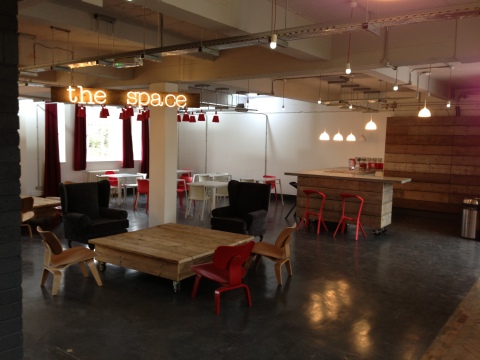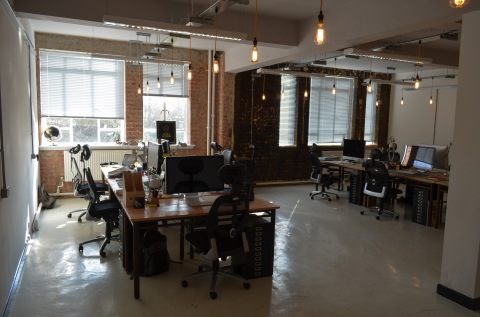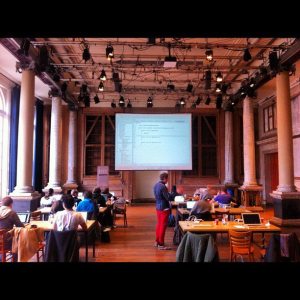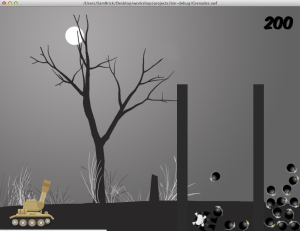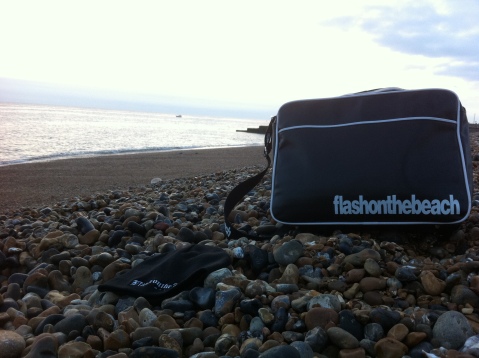Archive for the ‘Internet’ Tag
Temple Studios, Bristol: A New Space…
At the start of this month I moved offices into the new Enterprise Zone of Temple Quarter, Bristol. I have been a Bristol-based freelance Interactive Developer since 2007. I have thoroughly enjoyed my time working across several of the main digital/co-working hubs in the city. My latest stint involved a couple of years at the wonderful business incubation centre of Spike Design (you can see me playing table-tennis if you flick through the pics – exciting, no? 😛 ), in the equally lovely art and design centre of Spike Island. My time here was the best I have had in a co-working space: a very talented, diverse and friendly bunch of thirty-odd freelancers and small companies under one massive roof, often working together in a bustling beautiful building surrounded by probably the nicest section of the gorgeous Bristol harbourside. The cafe isn’t bad either. If you’re looking for a desk and somewhere great to work in Bristol, you should go and check it out….. And so it was with some trepidation that I decided to move into a brand new development in the new Enterprise Zone of Bristol.
Temple Studios has been built in what was the old Post Office sorting office and bills itself as a creative and digital campus. It’s a fascinating building of brick walls, parquet flooring, with a rustic, industrial edge located right next to the entrance of Temple Meads Station. The space has been fitted out with interesting lighting solutions, comfy furniture, break out spaces, communal kitchens and a desire for the companies and tenants within it to nurture and benefit form each other’s existence in this shared space. A table tennis table may have just turned up too 🙂
My situation within the building came about due to my old friends and colleagues Hype and Slippers taking a space within Temple Studios. They are a successful and up-and-coming digital agency populating their working habitat with a mixture of their own team members and freelancers. Having shared a co-working space previously with them in another great building, the Tobacco Factory, I was really excited to join forces again. They are an incredibly talented studio: “Creating high-quality, beautiful, well considered work across identity, print and digital design disciplines, we hand pick in-house and freelance talent on a per project basis.” – check out their work on Behance.
Alongside me in the office are some other great peeps who, in the short time I have been there, I have very much enjoyed my time with, namely:-
- Studio Chirpy is the freelance identity of Bristol-based graphic designer Max Saunders, delivering quality work through identity, print and web.
- 83 Pixels is the small but perfectly formed web design and consultancy of Shane Griffiths.
- Mitch Bartlett is a multi-disciplined designer.
- Motion Imaging aka Paul Thomas, a freelance front end web developer.
- Rosa Park is our newest member. She is the editor of Cereal: a beautifully produced quarterly food and travel magazine.
Around the rest of the building are an eclectic bunch of creative, (mainly) digital companies ranging from product designers to photographers, high-end 3D production houses to digital agencies. A couple of note, due to me being friends with them, are:-
- Atomic Smash are a digital and photographic agency.
- Red7Mobile are an mobile-app development house.
To conclude, I wanted to punctuate my new move to Temple Studios by documenting the kind of place it is and the sorts of people and companies you will find there. It’s an exciting time and the place has a really good buzz to it. It’s full of talented, creative and friendly people so if you get a chance to visit or want to join in, come and say hi. I have really high hopes for the area in general and it will be fascinating to be here and watch it as it develops. It’s one part of this fantastic city that has always felt like a bit of a let down, I don’t think this will be the case for much longer….
Making a Website Run Full-Screen on an iPad
Common knowledge really but thought I would post this in case it helps anyone else…..
If you want to run a website fullscreen in Safari on an iPad:-
- Add this line into the <head> – <meta name=”apple-mobile-web-app-capable” content=”yes”/>
- From Safari, save the site onto the home screen as a web app
My FITC Amsterdam 2012
FITC Amsterdam
I recently attended my first FITC event. FITC is focused primarily on high-end digital creativity. The conference took place in the wonderful city of Amsterdam over the end of February 2012. It was an intimate affair for a conference, with probably around 400 attendees. There was a workshop day on Sunday followed by two full days of presentations over three or four strands. There was a well-engineered mix of technical and creative talks by some key industry figures as well as some interesting sneak-peeks and major announcements. I am going to highlight some of the most interesting and important aspects of the conference (but in no way am I trying to cover everything as there was just too much to go over, and you would probably get bored 🙂 ).
The Sunday Workshop
I attended the Building Flash Games with Starling workshop hosted by Adobe Developer/Game Evangelist @LeeBrimelow. We spent a day building a 2D game from scratch using the new Starling Framework. Starling leverages the new GPU acceleration possible in Stage 3D but presents it in an almost identical way to Flash’s normal display list. This makes it easy for Flash developers to create incredibly performant 2D games simply by importing from the starling library instead of the flash library. There are obviously more steps to writing truly performant games but essentially you can achieve an awful lot for very little and we built a simple physics game called Grenades.
To create Grenades we used the impressive and more-intuitive-than-Box2D framework Nape. We also covered spritesheets and physics models using the awesome apps TexturePacker and PhysicsEditor. Grenades is very similar to the omni-present Angrybirds and Lee Brimelow did a great job of slowly layering on the code until we had a couple of levels of the game functioning with scoring, sound and even a (Flash IDE-based) level-editor.
HTML HTML HTML HTML HTML (that’s 5 HTMLs)
FITC, I believe, used to stand for “Flash in the Can” but has now been changed to “Future, Innovation, Technology, Creativity”. And this change was also mirrored in the content of the conference. In the industry there has been a huge shift in focus and excitent away from Flash to HTML5. At FITC there were only a handful of actual Flash specific talks and by the end of day one it was easy to have had the HTML5 logo burned into your retinas. So this was an HTML5-heavy affair and with good reason. For a conference that has a large percentage of (ex?)-Flash devs and designers, the issue that a lot of us are facing is how do we continue to build on what we do in the current and continually changing digital landscape? HTML5 has been heralded as the next big thing for some time now and many of the talks covered the reality of this new technology. Clients are asking for content to work on multiple platforms, behave performantly and not cost much or any more. However, the reality of achieving these things is a far more complicated picture.
Games for Kids: Flash vs HTML5
Jon Howard, @swingpants, is the Web Development Team Leader for CBBC & CBeebies and is the lead for BBC Children’s Games strategy team. He kicked off Monday’s presentations with an enlightening talk on his own journey to provide performant highly-interactive content for multi-platforms. His work thus far has included many, many impressive high-end Flash games. But with mobile and tablet-device usage percentages growing by the day this delivery method is going to have to change. Working for the BBC, it is his mission to reach the biggest audience possible and in catering for the lowest common denominator he has had to make some tough decisions about what he can realistically achieve. He wanted to get as deep an understanding as possible during his research so he decided to not use any frameworks or libraries and just start coding in HTM5 and Javascript to make a simple platform game. The kind of game you might typically find in the CBBC website.
His initial path, for the graphics side of things, took him to investigate SVG as an alternative to Flash’s vector graphics strength but found performance was massively lacking. So…. he went on to look at Canvas which is getting more and more powerful at the moment. However, he found that Android devices were incredibly slow at rendering Canvas. This left him with using DOM elements to render the game world and eventually, through a process of line by line code optimisation, he was able to get something passable working across his four different test devices.
Other issues he ran into included Android’s inability to use multi-touch gestures in-game. The terrible reality of sound implementation across browsers. Often a single sound is only possible, even worse, on iOS a sound must be triggered by a button. It’s so bad in fact that in @jessefreeman‘s latest book, ‘An Intro to HTML5 Game Dev’, he surmises that with current browsers it’s probably best not to even include sound at all…… no sound in games? Not good. Webcam access is only currently supported by Opera. Video requires multiple codecs and fallback strategies. Jon also found that performance for specific browsers is, on different devices in areas such as SVG, Canvas and CSS transitions, completely inconsistent and changes in random unexpected directions with almost every release. In particular, this is a problem with auto-updating browsers like Chrome….. it will suddenly update behind the scenes and your work will be broken or will have ground to a halt.
Basically, it’s still very rough out there. Things are getting better across the board, but very slowly. His conclusion was that HTML5 is not yet worth pursuing to make cross-browser multi-platform high-level web games. He speculated that this may be the case for some time to come as browsers implement their own take on features, in their own time, with very loose ‘standards’. He wondered if cloud-based streaming solutions like Onlive might actually be the answer….
The Adobe Keynote
It was an exciting keynote from Adobe. They have re-focused their direction for the Flash Platform towards high-end gaming and video. Flash’s name is mud right now and could be forever so there is an element of too little too late to a lot of this but what they were showing was truly impressive.
- AIR 3.2 finally has Stage3D hardware accelerated 2D and 3D running on mobile. They demoed a number of games running on mobile devices with truly impressive performance. Many thousands of sprites running at 60fps. There was a look at the incredibly performant framework Genome2D. Here are a few of the AIR demoes to check out – http://www.flashstreamworks.com/2012/02/28/five-air-3-2-stage3d-mobile-demos-that-will-knock-your-socks-off/
- Multithreading is almost here.
- New mouse capabilities are ready, including mouse-lock and full right-click control.
- There were some excellent Air Native Extensions allowing you to leverage device specific functionality not available in the AIR runtimes.
- They demoed the latest version of Unreal Engine running in Flash (through Alchemy). It is actually running better than on some modern day consoles. It was very impressive to see how far Flash has come. Many large game publishers are now starting to produce console-quality web content with the new Flask player capabilities. It was noted that although these super-high-end features are not necessarily relevant to a lot of people’s day-to-day work, the power and performance will trickle down to be leveraged in more common situations.
- Monocle is a Flash profiler that was announced a few months ago. It is going to run on top of release-version flash content and allow you to analyse each individual frame of a flash movie, you can click in and out of functions, manipulate the timeline to view any state of your application and pinpoint exactly where memory or performance issues may be occurring. It even works with Stage3D.
- Hellcat is Adobe’s name for a future edition of Flash Pro. It’s 64-bit rewrite allows for some impressive performance and realtime rendering in the IDE, also a 2 second load time. All this is great…. but I would rather just have an IDE that isn’t riddled with bugs and frequently crashes.
- Adobe Edge has now reached preview 4. It’s becoming an interesting tool for more basic end-to-end HTML5 visual solutions with limited interactivity. I’m not sure what kind of code is being generated under the hood but some of the latest examples were impressive.
- The most exciting announcement for me was the inclusion of part of Grant Skinner’s amazing CreateJS framework as an extension in Flash Pro CS6. This feature will allow designers to output complex vector-based canvas animations direct from the Flash IDE as .js classes. I am going to write a separate blog post imminently with much more information specifically on CreateJS.
For me personally, to make a snapshot of the technical mood of the conference, I would say this….. The digital landscape is changing fast, the dominant years of Flash have passed and we need to figure out how to do what we have done so easily in Flash in different technologies and on different platforms. The hype would lead you to believe that HTML5 will be able to solve everything but the reality is very complex and there are problems with performance, compatability and standards at almost every turn. Allowing one company to spearhead a web technology is dangerous in terms of ownership and control but it does allow for significant progress. Compare this to the slow-moving and differing implementations of standards by the multiple boards, committee and companies responsible for the current set of browsers and it’s easy to long for what seemed like a simpler past. However, that would be to ignore the excitement and challenge of developing in this new realm.
In terms of solutions, people are not sure what the right direction to take will be yet. There often isn’t a single clear choice but there are many breathtaking new frameworks, languages and technologies coming into play. I have been looking very seriously into haXe NME recently and it’s exciting and full of potential. I want to also look much more seriously at CreateJS as it reaches version 1.0. There is also other impressive tech such as Sencha, Phonegap and Spaceport, to name a few. In terms of performance, there is no denying the incredible ground being covered at the moment. Almost every week brings an improvement to the rendering and performance of mobile devices’ browsers. Soon, this won’t be the issue that it is now and this will give developer’s more choice and freedom. These are, without doubt, exciting times to do what we do.
I left out a great deal from this conference…. Grant Skinner’s awesome ‘HTML5 in the Trenches’ talk (which I’ll cover in my upcoming CreateJS blog), some excellent talks, presentations and free beer in the Influxis Voodoo lounge, the incredible atmosphere and friendly nature of the participants, Seb Lee-Delisle’s presentation ‘CreativeJS: Visual fun with Javascript’, as well as his ‘Conversation with Mr. doob’, an excellent opening party at the Sugar Factory, and basically, being in the beautiful city of Amsterdam. For anyone looking to go to a brilliantly inspiring, educational and valuable conference for digital creatives, this is right up there with the best of them. It’s like a musical festival for geeks! I will definitely try to come back again.
Excellent Article by Jesse Warden
I just read an awesome blog post by prominent interactive developer Jesse Warden. It covers an awful lot of interesting subject matter and busts some myths that are often heralded as truths within our industry. It’s a refreshing read that offers some clarity and insight into the world of interactive software development and it’s inherent career progression possibilities. I find myself and many other developer friends discussing these subjects at length, particularly in light of the splintering platforms of the current digital landscape, and I really enjoyed Jesse’s intelligent take on them all. Thank you Mr. Warden 🙂 Here it is:-
http://jessewarden.com/2011/10/five-lies-they-tell-you-in-software.html
My Flash on the Beach 2010 #FOTB
I recently returned from the Brighton based conference Flash on the Beach. It was my second year of attendance and once again I had an amazing experience. It has been a tough year for the Flash world and this definitely was a strong theme over the four days of talks and workshops. I caught a number of sessions related to establishing and understanding what has happened and how to adapt to the changes in the industry. I’m going to run through some of the highs and lows of this years conference and try and capture my thoughts and feelings about what was ultimately a really valuable time for me.
Highs
– Grant skinner kicked off Monday morning after the keynote. His talk was excellent as usual. He covered numerous projects that he has done that started out as experiments or play. He talked about how his adhd-like nature can lead him to distraction from client work sometimes and how he has harnessed this to create many interesting side projects, often feeding back into the client work and leading onto greater things. It was a fascinating and funny talk and a pleasure to watch. He went on to provide methods on how to invoke time to be able to do this, to take twenty minutes a day and devote it to coding fun, to “Find the time” and “Learn to love to learn”. He talks a bit about this theme on a recent post that can be found here. It is so easy to slip into the habit of neglecting to ‘play’ and this was a real reminder of the tangible benefits and enjoyment that can be drawn from doing so. Some of the examples of projects of this type included Androideroids, Regexr, Perfectr (as yet unreleased), Kaleidoscope and his Playing Records experiment.
– Lee Brimelow‘s talk entitled My Head Hurts was very insightful, pragmatic and encouraging and left me feeling positive about Flash’s future. Lee is a Platform Evangelist at Adobe. He made some interesting points and observations about the resulting fallout (and misinformation) generated by Steve Job’s ‘Thoughts on Flash’ blog.
– Seb Lee-Delisle‘s talk, ‘What the Flux?’ was probably my favourite of the conference and covered similar subject matter to Lee Brimelow’s. Seb decided to talk to some major players in the open web community to gain some perspective on how flash is viewed from outside our own community. What he discovered was quite sobering stuff and did not leave me feeling overly warm and fuzzy inside. There is obviously some venom felt towards the Flash community, and it was interesting to hear Seb say that it’s partially our own fault for the weaker aspects of the content we have produced over the years. The talk was great because it managed to trawl though so many complicated issues and summarise it all into really useful information and comment. The overall conclusion was that we all needed to keep on learning new tech, keep adapting and keep being passionate. It was a great call to arms and kick up the backside and definitely a talk worth watching, Flash developer or not, if you can find a link to it online. It ended in an on-stage game of Family Fortunes that he had built using an iPad and Wii-mote controllers. I also had the pleasure of talking to him at the bar afterwards and discussing his talk further. What an lovely guy he is.
– Iain Lobb‘s game design talk, ‘Zero to Game Designer in 60 Minutes’, was excellent. The venue was packed and many were unable to get in. He used a demo-suite created using his latest game-engine to illustrate the many subtle nuances that come together to make a pleasing gaming experience. You can play with his demo here. It enables you to play with camera movement, character movement, physics, feedback, enemy behaviour and many other components of gaming. One particular insight I loved was the explanation of how Mario games feel so ‘right’: Mario has three times as much gravity applied to him on the way down as he does on the way up.
– Seeing the work of artist/coder Robert Hodgin, the man behind the iTunes Visualiser!
– Bumping into the FDT team on Brighton Pier and chatting to them about their great product face to face.
– Having after-party drinks at the Dome Bar right at the conference. £1 drinks and plenty of room for everyone = much better!
– Stefan Sagmeister‘s manatee blowjob joke, oh, and his talk in general. Again, the theme was one of experimenting and play (in the context of sabbaticals). Inspiring stuff.
– Having at least one strand of every talk session being signed for the deaf audience.
– Leaving the conference feeling inspired, engaged, reinvigorated and ready to do more (this is probably the thing I like most about FOTB).
Lows (actually these were very hard to come up with…)
– Although I found it all quite amazing, I think I saw too much generative art this year.
– For me, there was a lack of talks containing tangible, valuable, help and advice such as gotchas, code examples or best practices.
___________
So all in all it was an excellent and valuable time. I will definitely be back again for more. Thanks to everyone involved for making it so good and to all the people I met and hung out with. It was a pleasure.
Grant Skinner on the Future of Flash
Grant Skinner is one of my favourite Flash devs. His work, presentations and contributions to the Flash community are absolutely amazing. I have been looking forward to hearing his thoughts on the fascinating subject of the future of Flash. Unsuprisingly he gives a very intelligent, mature, balanced and thoughtful perspective. Enjoy.
http://www.gskinner.com/blog/archives/2010/02/my_thoughts_on.html
What Happens When You Unplug from Your Internet Addiction?
I just read a fascinating article whose link was posted by a twitter friend Dan_HDistinct. It’s called “Lab Rat: What Happens When You Unplug from Your Internet Addiction?” and it was written by Brittany Ancell on the 99% blog. It made me think that there is a lot to be gained with some downtime from constantly being online. I am always leaving my computer on and checking emails, working and browsing and I think I might try to be more focused about my time (when/if my work schedule calms down!). Have a read here.
 Comments (1)
Comments (1)
